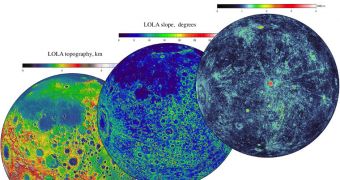The science group in charge of processing the readings taken by a NASA orbiter around the Moon have just released the final batch of data. The information were collected during the mission's exploration phase, which concluded some time ago.
At the same time, the experts also published data collected by the Lunar Reconnaissance Orbiter (LRO) in its new role as a scientific satellite. This is the other stage of this highly-successful mission.
The datasets were released on Tuesday, March 15, say experts at the American space agency in a press release issued to the media. Among the key features in the new release are amazing images and maps that provide geologists and planetary scientists with amazing insight into how the Moon looks like.
Some of the most impressive achievements LRO did include creating mosaic images of various aspects of the Moon, including a highly-detailed map of its dark side. Raw lunar data and other high-level products were also beamed back by the spacecraft.
All in all, the probe relayed more than 192 terabytes of detailed data back to experts managing it. The team reveals that it would take 41,000 DVD discs to contain all the data the LRO produced while investigating Earth's natural satellite.
“The release of such a comprehensive and rich collection of data, maps and images reinforces the tremendous success we have had with LRO in the Exploration Systems Mission Directorate and with lunar science,” explains Michael Wargo.
The official holds an appointment as the chief lunar scientist of the Exploration Systems Mission Directorate, at the NASA Headquarters, in Washington, DC.
“Because the Moon is so close and because we have a dedicated ground station, we are able to bring back as much data from LRO as from all the other planetary missions combined,” adds Richard Vondrak.
The expert, who is based at the NASA Goddard Space Flight Center (GSFC), in Greenbelt, Maryland, holds an appointment as a project scientist with the LRO mission. He says that some of the products the LRO sent back include a LRO Camera (LROC) mosaic.
The image has 1.1 gigabytes, and features a resolution of 34,748 pixels by 34,748 pixels. This means experts and amateurs alike can use it for studies of the lunar surface in unprecedented detail.
“All these global maps and other data are available at a very high resolution – that's what makes this release exciting,” adds LRO deputy project scientist John Keller, who is based at the GSFC.
“With this valuable collection, researchers worldwide are getting the best view of the moon they have ever had,” he concludes.

 14 DAY TRIAL //
14 DAY TRIAL //